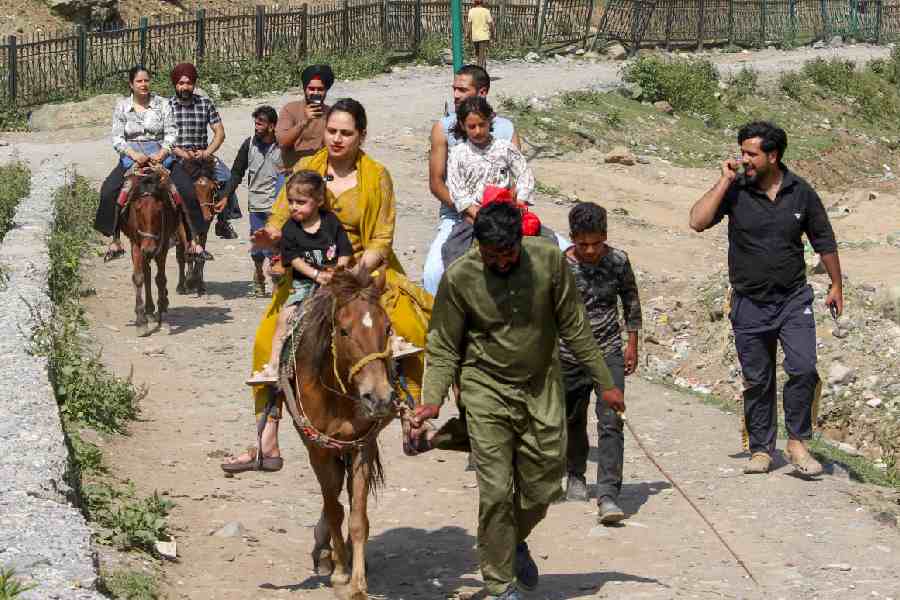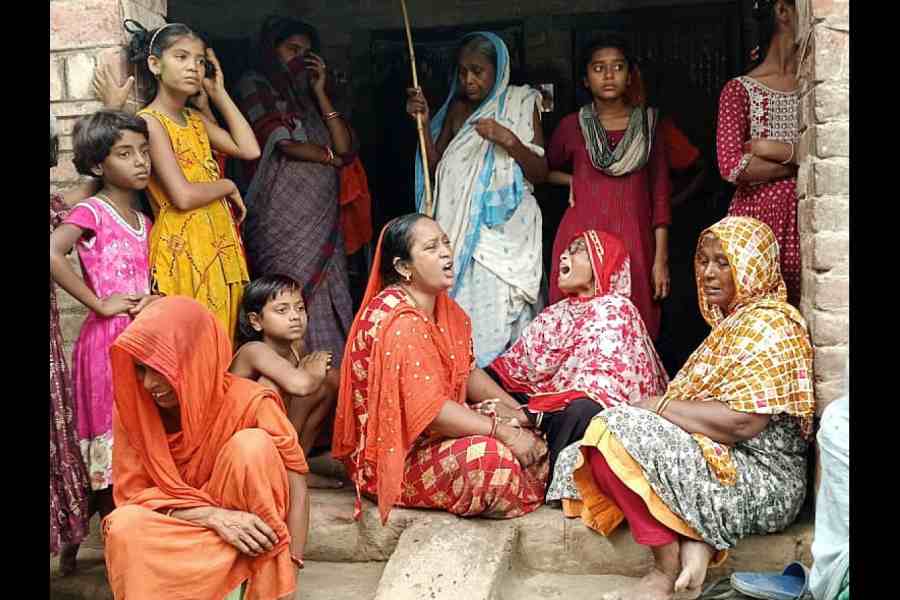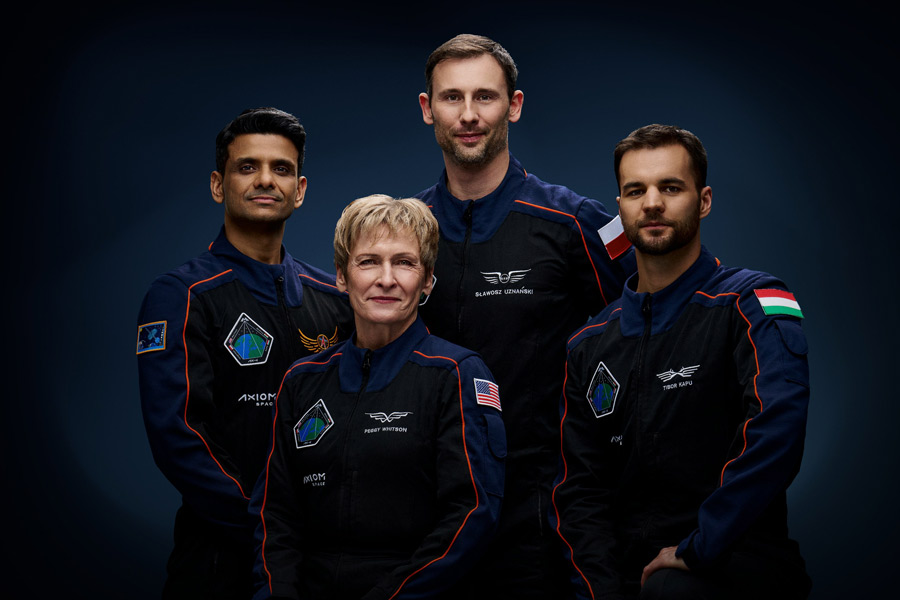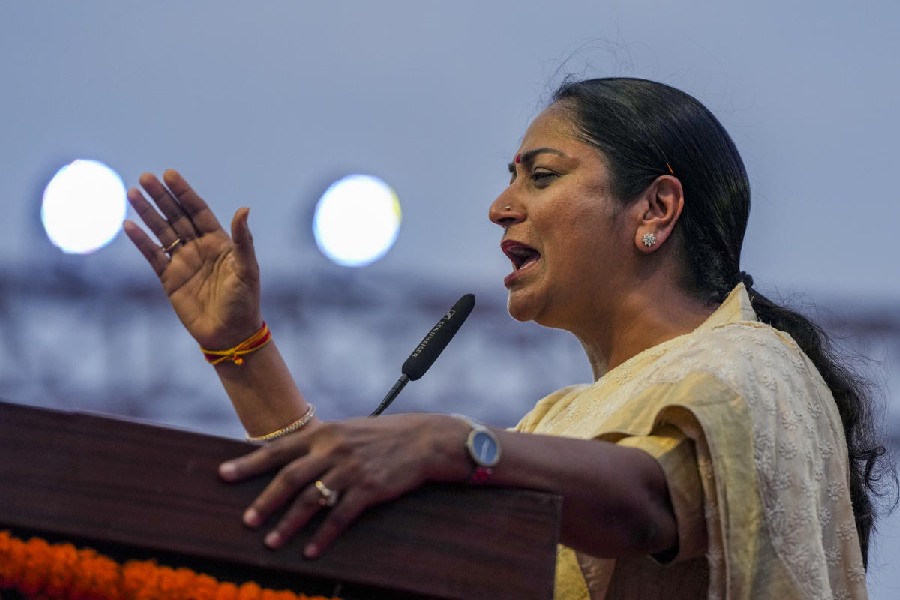 |
| Tanmoy Chakraborty with Aparna Sen on the sets of Goynar Baksho. Saswata Chatterjee is behind them. (Below) At home with antique items. (Sudeshna Banerjee) |
.jpg) |
Less than a week into her marriage, Tuli Basu woke up with the sun in her eyes. Where were the drapes in the window, she wondered, turning away. Then she heard a voice asking her to move to the other side of the bed and sensed the blanket being dragged from beneath her. “I woke up with a start to find the cupboard bare and all our wedding gifts being wrapped in the curtains and blankets. I never saw them again.”
This is not a tale of yet another heist. The culprit was none other than Tuli’s husband Tanmoy Chakraborty, the art director of films like Goynar Baksho, Aarekti Premer Golpo, Meghe Dhaka Tara and Joddha. He had quit a job with a TV channel and was starting out independently. That was 14 years ago and those would be his props in the screen assignments he had taken on.
“My first love was acting,” says the 43-year-old BL Block resident. “I also loved painting. That drew me to art college.” But a chance meeting with art director Gautam Basu in Digha proved to be a turning point. “I had casually told him that I’d visit his sets. When I did, it was a revelation. Outside it was all tattered cloth and plyboards jutting out. Inside was a palace! I wanted to learn how it was done.” He assisted Basu for the next year-and-half before joining Ramoji Films. His first film Prahar released in 2003. Then came Bow Barracks Forever. “(National Award winning art director) Samir Chanda liked my work so much that he referred me to Mani Ratnam and Mira Nair.” He has never looked back since.
“With things disappearing from home, my family used to wonder what exactly my job was. To be very frank, other than acting, we are involved in everything. When I hear a script, I start visualising if the person is rich or poor, is a public servant or works in a private firm, if there’s a child in the house or not….We have no text book. It’s all a matter of sensibility and eye for detail.”
Chakraborty buys props worth lakhs every month. “Dakshinapan shop-keepers to owners of auction houses — they all know me.”
An art director’s life is tough. “After the pack-up call for the day we are handed the requisition list for the next day’s shot. By 6am, we have to get it all if there’s a morning schedule.” He recalls how in Mani Ratnam’s Yuva, the backdoor of Writers’ Buildings was to be shot as the front door. “I had to get an asbestos shade and 60 sandbags overnight (for the police post).” A building contractor known to his driver finally saved the day.
As art director, he has to recreate the director’s vision. “When I was doing props research for Goynar Baksho, I had shown the picture of an antique German silver brush to Rinadi. It was to be used in a scene where Konkona (Sen Sharma) would brush Saswata (Chatterjee)’s coat. But when the shoot started three months later, I realised I had used the brush in Lootera (where he was in charge of art direction in the Bengal leg) and it was no more with me.” But Aparna Sen would not have a wooden brush. “I walked four-and-half hours that day and finally bought a brush of pure silver. It adorns my bedroom now.”
Unforeseen events throw challenges. “I had prepared a set over 20 days replicating an actual bogey in a train where Irrfan Khan’s accident would be shot in The Namesake. But a day and half before the shoot, we were told that the bogey we were given would be changed as its lights were out. I raced against time to change the decor of the set. Later Mira Nair told me no other production designer in the world would have taken the challenge.”
.jpg) |
| At a felicitation by the block association on Nava Varsha this year with daughter Tushnee |
One of the toughest challenges was creating the sets for Aarekti Premer Golpo in which Rituparno Ghosh was both the lead actor and the creative director. “The first day I was so nervous I didn’t make the bed thinking he’d prefer to get it done his way. But he told me to go ahead. The second day he took a look and said: ‘Soot up the lamp, attach a frill to the palm leaf fan.’ I realised I had passed the test.” That was to be Chapal Bhaduri’s room in his Tarapith house in the film.
In his view, Rituparno Ghosh was the best production designer ever. “He taught me the use of property collection. When the oven got changed in our kitchen, I preserved the old one in my godown.” Chakraborty has bought 2,500sq-ft space in Tollygunge where he stocks anything that catches his eye. “A lot of times the production house cannot afford to buy everything or even money can’t buy what is needed right then. I had seen a chessboard in an auction house and bought it for Rs 5,000. Later, it got used in a sequence in Lootera.”
He admits when he sees a film the decor draws his attention more than the action. “If it is my own work, I am looking out more for lapses. In Goynar Baksho, for instance, Saswata takes a sip from a cup handed by Konkona. No one noticed it but I could see my signature underneath the cup. That should have been erased.”
Since he is majorly involved in TV serials too (those currently on air include Raj Jotak, Rashi and Raikishori on Zee Bangla and Ishtikutum, Jalnupur, Badhubaran and Kiranmala on Star Jalsha), he faces questions from his mother-in-law’s friends and neighbouring women on which way the story would turn — “Will they get married? Will he get released from jail?” He doesn’t mind as he also gets feedback on his work from them.
He has been a Salt Lake resident since his graduation days, shifting between rented accommodations in CA, AE and BJ blocks in the 90s before settling in the BL Block house that his wife inherited post-marriage in 2001.
After fighting shy of Puja pandals all these years, he took the plunge this autumn with Netaji Jatiya Seba Dal, Ranikuthi. The handsome haul of awards meant a queue of 17 to 18 clubs wanting to sign him. “But I’ve asked them to wait. My schedule is packed till July — Srijit Mukherji’s Rajkahini, Aparna Sen’s Romeo Juliet.... If nothing major crops up immediately afterwards only then will I take on Puja assignments.”
After 18 years in the industry and 72 films, Tanmoy knows that the grind exceeds the glamour. “When a fine arts student wants to join this profession, I tell him of the negatives first. Since we work during lunch breaks, often the food would be over by the time we are done. If the stars come at 7am, we have to reach by 5am.” He has set himself a deadline. “I will retire once I do 100 feature films,” he smiles.
• What is your message for Tanmoy Chakraborty? Write to saltlake@abpmail.com or
The Telegraph Salt Lake, 6, Prafulla Sarkar Street, Calcutta 700001










